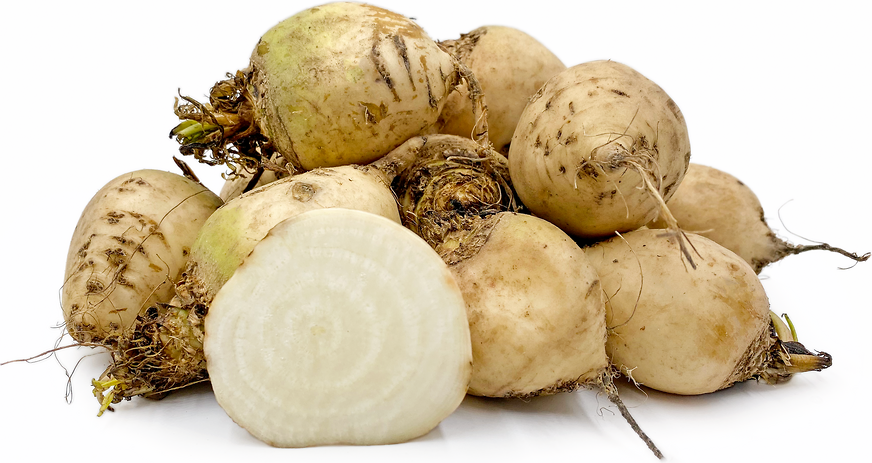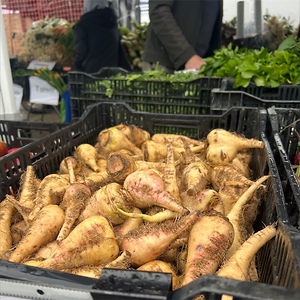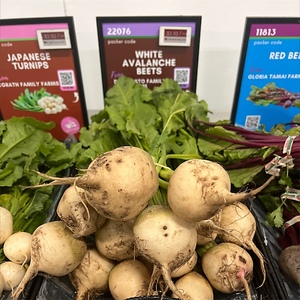


White Beets
Estimated Inventory, lb : 0
Description/Taste
White beets are generally round to conical roots, averaging 5 to 12 centimeters in diameter, but the appearance of the beet may vary depending on the specific variety and growing conditions. Attached to the root, there are also elongated, wavy leaf tops that are thick, crisp, and dark green, growing in a rosette pattern. The skin of the root is semi-rough, firm, and cream-colored, sometimes covered in scrapes, scars, and root hairs. Underneath the surface, the flesh is dense, crunchy, and white with faint concentric rings. White beets, when cooked, develop a soft and tender consistency with a mild, subtly sweet, and neutral flavor.
Seasons/Availability
White beets are available year-round.
Current Facts
White beets, botanically classified as Beta vulgaris, are edible roots that belong to the Amaranthaceae family. There are many different varieties generally labeled as White beets in local markets, and the pale roots are considered to be some of the rarer beet cultivars, often overshadowed by their red, striped, and orange counterparts. White beets are most famously known for sugar beets, which is one White beet variety that is globally used for the commercial production of sugar. Beyond sugar beets, other varieties of White beets are increasing in popularity among home gardeners for their mild flavor as the pale roots lack the typical earthy, dirt flavor associated with red beet cultivars. Some of the well-known White beet varieties include White Detroit, Albino, Avalanche, and Blankoma. White beets can be found in baby sizes and are also grown to maturity for use in both raw and cooked culinary applications.
Nutritional Value
White beets are a good source of fiber, which can help stimulate digestion and also contain some vitamin C, manganese, folate, potassium, and magnesium. In addition to the roots, the leafy green tops provide vitamins A and C, which are antioxidants that can boost the immune system, increase collagen production, and help reduce vision degeneration. They also contain some copper, iron, magnesium, and calcium.
Applications
White beets are best suited for both raw and cooked applications such as roasting, boiling, steaming, and baking. The skin should be peeled and discarded before consumption, and once cleaned, the flesh can be finely grated into salads as a crisp ingredient or pressed into juice. White beets can also be steamed and quartered into winter green salads and potato salads, boiled into soups, cooked into risotto, or roasted with bitter root vegetables for a sweet and savory side dish. In the Netherlands, a cold salad known as koude schotel is traditionally made with ingredients such as red or White beets, apples, cheese, pickles, meat, or potatoes to create a sweet and tangy dish. Some varieties of White beets can also be cooked and pressed to make syrups and sugar, or they can be pickled for extended use. In addition to the roots, the green tops of the beets can be washed and lightly sautéed as a side dish. White beets pair well with herbs such as tarragon, parsley, mint, and dill, cheeses such as parmesan, goat, and gruyere, almonds, apples, grapefruit, potatoes, pine nuts, and yogurt. The roots will keep 1-2 weeks when stored whole and unwashed in the crisper drawer of the refrigerator.
Ethnic/Cultural Info
White beets lack betalain, which are the pigments found in the flesh that give other beet varieties their red, orange, and yellow hues. These pigments act as antioxidants, but they also contribute to the beet’s polarizing, earthy, and semi-bitter flavor. Since White beets do not contain these earthy flavors, they are heavily marketed in the United States for their mild and sweet taste to attract consumers who usually dislike the flavor of other beet cultivars. The roots are also promoted for their lack of staining pigments in their juice, which other beet varieties normally possess. One variety of White beet, the Avalanche, was notably recognized for its mild flavor and won the All-American Selection Edible Vegetable award in 2015. All-American winners are selected by a panel of expert judges who extensively test selections for flavor, quality, and superior growth characteristics.
Geography/History
White beets are believed to be native to Europe and have been cultivated since ancient times. While the exact origins of White beets are unknown, the plant was initially consumed for its leafy green tops, and the roots were discarded and used as animal feed. Consumption of the mild-flavored roots became popular during the 1800s, and with the discovery of the beet's high sugar content, White beets became an important commodity within agricultural trade for sugar creation. Today White beets are rare to find in fresh markets as they are primarily grown for commercial processing around the world. Some White beet varieties can be found through local farmer’s markets in Europe, the United States, South America, Australia, and Africa, and the seeds of White beet cultivars are also sold through online seed catalogs for home garden use.
Recipe Ideas
Recipes that include White Beets. One
| Max Living |
|
Char-grilled Chicken Salad with White Beets |
| Bon Appetit |
|
Grapefruit and White Beets with Yogurt and Tarragon |











